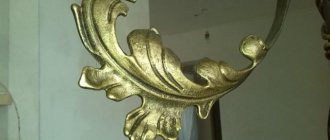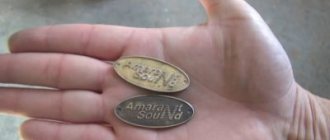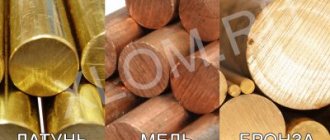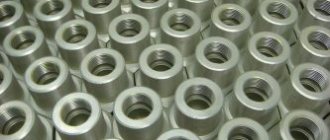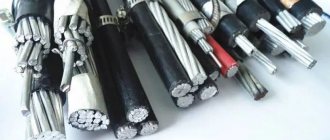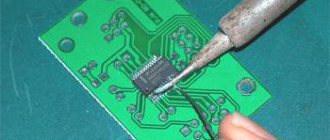A metal alloy based on copper and zinc can visually resemble both bronze and gold. Due to its strength and excellent appearance, the material is widely used in everyday life. Before purchasing a metal product, you need to know whether brass rusts.
Alloy rod Source alta-gamma.ru
From forums about passivation of brass
It is required to master the passivation of brass.
Of the recipes I know only sulfuric acid + nitric acid and then chromium. But there is no desire to tinker with acids unless absolutely necessary. Could you please tell me, dear colleagues, if there is any more modern and less harmful chemistry. Maybe from the field of jewelry practice... Or maybe there is some decent varnish. Excerpt from the book: Handicraftsman's Handbook Print based on the book 'Industrial techno-chemical formulation' compiled by G. G. Broderson 3rd edition Moscow 1931
“... d) In golden colors. I) Small brass items, such as buttons, clasps, buckles, etc., can be painted golden yellow by immersing them on copper wire in a neutral solution of copper acetate. The solution should be completely neutral, that is, it should not change the color of either red or blue litmus paper. Its neutralization, if necessary, is carried out with acetic acid. II) Take 4 caustic soda, 4 milk sugar and 200 water and boil for 15 minutes, gradually adding 4 concentrates. sol. copper sulfate. The finished mixture is cooled and then brass items, previously cleaned of grease stains, are placed in it. After a short bath, the brass takes on a beautiful golden yellow hue. III) Small brass items, e.g. buttons, clasps, buckles, etc. can be painted golden-red by rubbing a mixture of 4 washed chalk (powdered) and 1 gold leaf, moistened with water to a paste consistency. Gold leaf is nothing more than sulphide (disulfide) of tin; it is similar in color to real gold and, like the latter, does not change from atmospheric influences. IV) To give copper a golden-red (orange) color, immerse it after thorough cleaning for a few seconds in a crystal solution. Yari verdigris. V) Dissolve 15 g of sodium sulfate in 30 g of water, add 10 g of antimony chloride solution, heat to a boil, filter and rinse the resulting reddish precipitate in the filter several times and dilute it in 2-3 liters. hot water. While heating, add as much strong caustic soda solution until the precipitate dissolves. Immerse brass items in hot liquid and leave in it until they are painted the desired color. ..." I haven't tried it myself.
There is a section on the Jewelry Forum of the City of Masters
Now I have a Brass drive for Benya from the Workshop of ivanh00ev and rvg1. And although the anti-corrosion properties of brass are far superior to those of aluminum, as inexorable facts testify, it is still not stainless steel, and therefore it must be protected somehow. The question is - how?
Has anyone tried these recipes? Although, it seems, only the 1st and 2nd methods provide surface protection from oxidation, the rest are just colored decorations.
(c) “I sold the copper ring for gold” (film “His Excellency’s Adjutant”)
I didn’t wait for an answer, so I tried it myself first. Moreover, the first recipe, which, as it seems to me from the compositions and processes, most reliably protects brass from oxidation. It is also the most labor-intensive and unsafe -
Here are your first pancakes. Do you feel the difference?
The difference is clearly visible: after passivation, the steel reflection disappears and the surface becomes bright yellow and matte.
1. The very first thing we do is go to a hardware store and buy safety glasses - for example, these:
Because negligence when working with acids, especially such strong ones as sulfuric and nitric, as a rule, ends very sadly... Put plastic glasses worth $3 and your invaluable vision on the scales - and your steps will automatically speed up in the right direction.
2. It’s also worth saving your hands, so we go to the pharmacy and buy rubber gloves - ten for a dollar. The hands in them quickly sweat from lack of air, and they will have to be changed often.
3. We stock up on jars in the china shop. Their volume depends on the size of the parts being passivated. It is better to choose the minimum required volume of jars - this will save on reagents. The material of the jars can be made of plastic, with the exception of containers for acids - they must be glass. Moreover, to mix acids you need to make a “matryoshka” - a jar of smaller capacity is placed in a jar of larger capacity. It wouldn’t be a bad idea to make a “triple nesting doll” - acids are very insidious, and they also get very hot when mixed.
4. And finally, we go for chemicals. In any town of the size of a province or higher, there will definitely be such a store - it is usually called “ChemReagents”. In it, you may have to show miracles of ingenuity to buy three reagents - sulfuric acid, nitric acid and potassium dichromate (“chrompic”):
Sulfuric acid. It can be concentrated, or it can be diluted. We need concentrated. There is chemically pure acid, but this is not necessary for our ventures. It can be sold in plastic containers, but this plastic is special - acid-base resistant. Outwardly it looks like a calm, colorless, oily liquid, something like olive oil. But make no mistake - this is a very formidable acid! Nitric acid. This acid is a hurricane - even planes fly on it! Even outwardly, she betrays her violent character - an acidic “smoke” always curls over her, warning of danger. This acid also comes in different concentrations, and although concentrated is not necessary for us, it is desirable.
Try not to drop other chemicals, even water, or foreign objects into these acids - the consequences can be unpredictable!
Potassium dichromate. He is also a “chrompic”. Actually, there are different types of chromium, we need this one - potassium dichromate. It is a red crystalline powder. It’s toxic – that’s why it’s red; nature sometimes warns us of danger. Therefore, once again - glasses, gloves, no alcohol in the body and extreme caution!
Oh yes, I almost forgot to tell you about the wonders of ingenuity when purchasing reagents. I don’t know how it is in Mother Russia, but in our independent country, someone’s smart head (apparently smarter than they were in the Soviet of Deputies) came up with the idea of imposing a ban on the free sale of some reagents - ordinary pharmaceutical “potassium permanganate”, acids and other chemicals, which apparently make it possible to create either a nuclear rector or a drug cartel with the help of simple improvised means, have not been precisely established by science. In any case, concern for the people has been demonstrated, and the list of reagents prohibited for sale is the so-called. “precursors” was approved, and the state budget was replenished through the sale of licenses. And therefore, in response to a harmless request to sell acid, you will be shouted at - “Do you have a license for precursors?!” Of course, where did you, a simple air gunner, get such a cunning...wise license? You probably don’t even have a license for pneumatics, which are capable of up to 30-40 J, not to mention the mysterious “precursors”.
The most effective ways
Before you begin cleaning a brass item, you should examine it carefully. It can be made entirely of brass or alloy, or have a lacquered finish. Depending on this, the appropriate cleaning method is selected. It is not recommended to clean rare items, as this removes many years of patina, which gives special beauty and value to the historical item.
Before cleaning brass at home, the item must be thoroughly washed. This is carried out in a solution consisting of 10 liters of ordinary water with a mild detergent dissolved in it (1 tsp). The item is placed in a container with this liquid for 30 minutes, after which it is thoroughly washed with a soft brush or rag. This removes existing dirt, blackness, and green deposits. After each procedure, the item is wiped dry. Next, they move on to the main stage of cleaning the brass object using one of the methods that can be found in the video.
Oxalic acid
This acid is practically never used in its pure form. It is found in many detergents for cleaning bathtubs, tiles, and washbasins. The liquid preparation is applied to the item for a while until the product becomes dark in color. After this, the product is treated with a brush with the dissolved oxide and covered with baking soda. At the end of the procedure, the item is washed under regular running water.
Brass items that have not been cleaned for a long period have a thick layer of oxide. The use of products with a small amount of oxalic acid is ineffective in this case. These products are processed using a different method. Effectively cleaning brass at home when it is heavily oxidized requires preparing a concentrated solution. It consists of 200 g of acid, as well as 10 liters of ordinary water.
As a result of a chemical reaction on an object placed in a liquid, the surface should darken. After this, it is kept under running water and wiped dry. Please note that oxalic acid is a caustic solution, which requires the use of a respirator and protective gloves.
Acetone
Using acetone allows you to thoroughly clean the outside of a brass item from oxides. Under its influence, the outer surface will begin to shine and take on a beautiful appearance. A small cotton swab is moistened with a solvent, after which the product is wiped. It is necessary to clean the surface until the plaque is completely removed. If there is no visible result, pre-soaking is carried out. To do this, use an aqueous solution with vinegar and salt, which is brought to a boil. To increase the processing efficiency, brass items should be boiled for 3-4 hours. Darkening of the surface of the product is normal, which will gradually disappear during the soaking process.
Before cleaning contaminated brass with acetone, you need to know that it is not suitable for treating things that have a lacquered layer. The varnish may completely dissolve, which will require subsequent restoration of the coating.
Toothpaste
You can clean a brass product using your usual toothpaste. The item to be cleaned is washed in a soapy solution to remove and soften massive dirt. After this, a small layer of toothpaste is applied to problem areas. Use a regular napkin to clean the surface. The toothbrush is used exclusively for working in hard-to-reach areas.
Acetic and citric acid
To remove old stains on a brass surface, create a mixture of water, one glass of flour, and table vinegar. It covers the outer surface of the object and waits until the solution dries completely. After this, the mixture is removed from the product and polishing is carried out. You can use hot vinegar yourself. To do this, it is heated on a home stove and applied with a cotton swab to the area to be cleaned. The heaviest areas require multiple treatments.
Read also: Service life of water pressure reducer
Removal of oxides and stains is also done with citric acid. Juice is squeezed out of one lemon, salt is added to it until a paste-like mass is obtained. It is applied to the product, gently rubbed, and then washed off with ordinary running water. Don't forget to wipe the shiny brass thing dry.
Sandpaper
Heavily smoked brass products are cleaned with fine-grained soft sandpaper. In this case, the pressing force should be small to avoid damaging the surface of things. Hard-to-reach areas are additionally cleaned using a chemical method.
Soap solution
This solution is used to soak brass items. With mild oxidation, this procedure is quite sufficient to give the item the required appearance. Laundry soap (shavings) dissolves in a bowl of warm water and foams. Brass objects are placed in the liquid and left for several minutes until it cools. After this, the solution is drained and the items are cleaned with a soft bristle brush under running water.
You can add shine to brass items at home using regular table salt with a little lemon juice. In addition, use a mixture of 0.5 liters of buttermilk and 1 tbsp. l. salt. These methods allow you to remove even heavy dirt on the surface of objects and give them a good shine.
Another way is to use fine salt (1 tbsp) with skim cream. The paste is applied to the surface and wiped. For heavy areas, it is necessary to soak the mixture for one hour. At the end of the procedure, the item is washed with water and wiped. Before cleaning brass with salt, make sure it is completely dissolved so as not to damage the item being cleaned.
Specialized means
These drugs are sold in various stores and consist of a concentrated acid solution. These oxide converters are quite effective for items with problem areas. The cleaning procedure is carried out in full accordance with the instructions for the product. At the end of the process, the object must be rinsed to remove any remaining solution. These preparations do not allow the brass surface to oxidize for a very long period, and also maintain its good shine.
Varnishing of metals.
... Take a can of aerosol varnish, you need to warm it up a little in a water bath, or hold it in a bowl with boiling water .. (heating helps to reduce the grain and more accurate application) under a good powerful lamp, preferably with a reflector, apply 3 thin layers ... each next - after drying of the previous one.
... I print out and cut out the picture (some old map). I glue it and fill it with tsaponlak in several stages. The metal is also varnished.
The key fob had been hanging on the keys the entire time. The varnish has come off almost everywhere, but the picture holds up like a glove.
- Trou
- 19 January 2013, 15:41 7
- 0 0 0
- Trou
- 19 January 2013, 15:45
- bronzoviygorgul
- 19 January 2013, 16:27
- +2
- Trou
- January 19, 2013, 21:32
- +1
- Avsey
- 19 January 2013, 17:53
I'll tell you how I once varnished a flash drive. There was an order for a flash drive, and the customer ordered the flash drive with varnish, he didn’t want it to lose its shine. I bought a can of aerosol varnish, as it was written for automobiles! In general, I applied 3 layers, and everything shone well, everything was great, but literally a week later all this varnish was covered with a “cobweb” and naturally dirt got clogged there, and it became even worse than if it had not been there at all! I had to peel it off, so it was left without varnish.
Is it some kind of varnish or something??
- Avsey
- January 19, 2013, 18:00
- Gur_man
- January 19, 2013, 20:46
I've also heard about two-component varnish, but I've never used it.
- Vovka_BC
- January 19, 2013, 21:07
- Vovka_BC
- January 19, 2013, 21:06
- Trou
- January 19, 2013, 21:51
- Avsey
- January 19, 2013, 22:00
- Trou
- January 19, 2013, 10:18 pm
- +3
- catan
- January 19, 2013, 10:46 pm
- +1
- Trou
- January 19, 2013, 11:18 pm
- catan
- January 19, 2013, 11:44 pm
- +1
- bikalbert
- January 20, 2013, 00:42
- catan
- January 20, 2013, 10:54
- Gur_man
- January 19, 2013, 20:48
- +1
BUT SHE LIVES (i.e. the color, shade changes.)
+one hundred500 I read the topic and already wanted to write about the same thing, but I decided to also read the comments... Non-ferrous metals embodied in products are beautiful in their inconstancy, even with a temperature change the color changes, not to mention the passage of time
